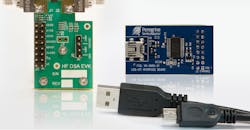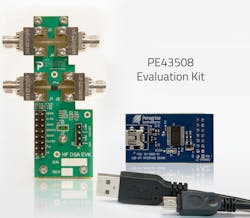Download this article in PDF format.
Whether now as pSemi or formerly as Peregrine Semiconductor, the company has shown that its UltraCMOS silicon-on-insulator (SOI) semiconductor technology is quite capable of excellent electrical performance well into the millimeter-wave (mmWave) frequency range. Its latest demonstration is the model PE43508 digital step attenuator (DSA), a monolithic IC with 6-b digital control of a 31.5-dB attenuation range in 0.5- and 1.0-dB steps across the impressively wide frequency range of 9 kHz to 55 GHz.
With such high frequency coverage, this tiny step attenuator is well-suited for precision level control in various automotive and 5G mmWave circuits and test equipment. It maintains accurate attenuation across the attenuation and frequency ranges, with low return loss and insertion loss. In addition, it changes attenuation levels with 330-ns switching speed.
Model PE43508 is a 50-Ω IC DSA that can maintain 0.5-dB (or 1.0-dB) monotonicity across its 31.5-dB (or 31.0-dB) attenuation range. And it changes attenuation levels without positive glitches throughout the frequency range. As a result, no power spikes or attenuation errors occur even during constantly changing attenuation, as in an automatic-test-equipment (ATE) applications or satellite-communications (satcom) terminals. It’s a high-performance companion to the company’s two 60-GHz UltraCMOS switches (models PE42525 and PE426525) for mmWave circuit and system applications.
Accurate Attenuation
The DSA’s RF performance is superior even across the wide frequency range. It’s aided by the company’s HaRP technology to achieve reduced gate lag and low drift in loss characteristics—the DSA suffers relatively low insertion and return losses through 55 GHz. For example, typical insertion loss is 4.7 dB from 26.5 to 45.0 GHz, 5.3 dB from 45.0 to 50.0 GHz, and 5.9 dB from 50 to 55 GHz. Typical return loss is 16 dB from 13.0 to 26.5 GHz, 14 dB from 26.5 to 45.0 GHz, and 13 dB from 45 to 55 GHz. The worst-case attenuation error is within +10% to +12% of a reading at the highest frequencies. The attenuator has a typical third-order input intercept point (IIP3) of +50 dBm
The DSA supports 1.8-V control signals and has an optional VSS_EXT bypass mode. Its digital control interface allows both serial-addressable and parallel-programming modes. It can be controlled with direct-parallel, latched-parallel, and serial-addressable programming. The attenuator can also operate in normal or bypass modes. In normal mode, it runs with a single positive supply from 2.3 to 5.5 V and typically 170 µA. Bypass mode adds a negative −3-V supply (at typically 16 µA) with a positive supply from 3.1 to 5.5 V (at typically 122 µA).
Shown on an evaluation board as part of a development kit, the PE43508 single-chip SOI digital step attenuator provides as much as 31.5-dB attenuation from 9 kHz to 55 GHz.
The PE43508 is supplied as a flip-chip die, but it can also be mounted on ready-to-test printed circuit boards (PCBs) as part of evaluation kits (see figure). It features a human-body-model (HBM) electrostatic-discharge (ESD) rating of 1 kV and an operating temperature range of −40 to +105°C. P&A: $50 (USD, 1000 qty.); samples.
pSemi Corp. (formerly Peregrine Semiconductor and a Murata Co.), 9369 Carroll Park Dr., San Diego, CA 92121; (858) 731-9400.
About the Author
Jack Browne
Technical Contributor
Jack Browne, Technical Contributor, has worked in technical publishing for over 30 years. He managed the content and production of three technical journals while at the American Institute of Physics, including Medical Physics and the Journal of Vacuum Science & Technology. He has been a Publisher and Editor for Penton Media, started the firm’s Wireless Symposium & Exhibition trade show in 1993, and currently serves as Technical Contributor for that company's Microwaves & RF magazine. Browne, who holds a BS in Mathematics from City College of New York and BA degrees in English and Philosophy from Fordham University, is a member of the IEEE.


